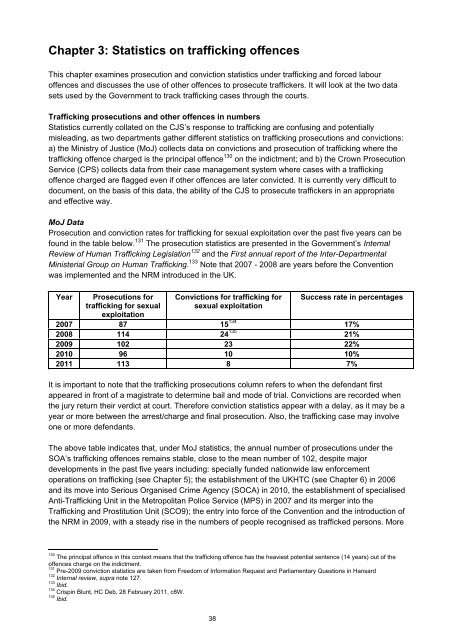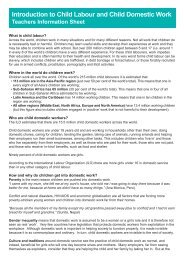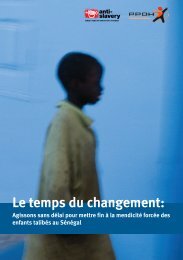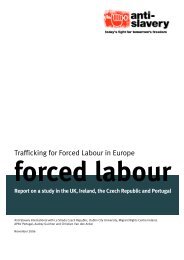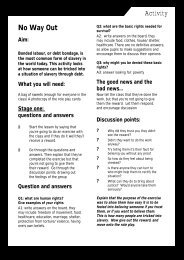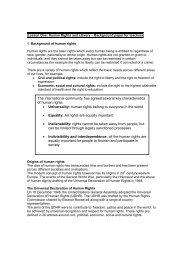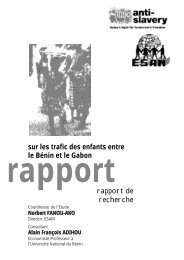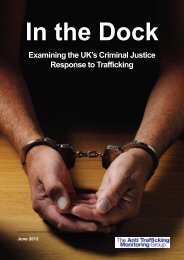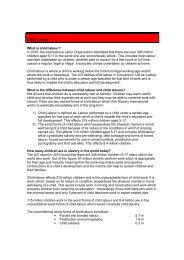Chapter 3: Statistics on trafficking offencesThis chapter examines prosecution and conviction statistics under trafficking and forced labouroffences and discusses <strong>the</strong> use of o<strong>the</strong>r offences to prosecute traffickers. It will look at <strong>the</strong> two datasets used by <strong>the</strong> Government to track trafficking cases through <strong>the</strong> courts.Trafficking prosecutions and o<strong>the</strong>r offences in numbersStatistics currently collated on <strong>the</strong> CJS’s response to trafficking are confusing and potentiallymisleading, as two departments ga<strong>the</strong>r different statistics on trafficking prosecutions and convictions:a) <strong>the</strong> Ministry of Justice (MoJ) collects data on convictions and prosecution of trafficking where <strong>the</strong>trafficking offence charged is <strong>the</strong> principal offence 130 on <strong>the</strong> indictment; and b) <strong>the</strong> Crown ProsecutionService (CPS) collects data from <strong>the</strong>ir case management system where cases with a traffickingoffence charged are flagged even if o<strong>the</strong>r offences are later convicted. It is currently very difficult todocument, on <strong>the</strong> basis of this data, <strong>the</strong> ability of <strong>the</strong> CJS to prosecute traffickers in an appropriateand effective way.MoJ DataProsecution and conviction rates for trafficking for sexual exploitation over <strong>the</strong> past five years can befound in <strong>the</strong> table below. 131 The prosecution statistics are presented in <strong>the</strong> Government’s <strong>In</strong>ternalReview of Human Trafficking Legislation 132 and <strong>the</strong> First annual report of <strong>the</strong> <strong>In</strong>ter-DepartmentalMinisterial Group on Human Trafficking. 133 Note that 2007 - 2008 are years before <strong>the</strong> Conventionwas implemented and <strong>the</strong> NRM introduced in <strong>the</strong> UK.YearProsecutions fortrafficking for sexualexploitationConvictions for trafficking forsexual exploitationSuccess rate in percentages2007 87 15 134 17%2008 114 24 135 21%2009 102 23 22%2010 96 10 10%2011 113 8 7%It is important to note that <strong>the</strong> trafficking prosecutions column refers to when <strong>the</strong> defendant firstappeared in front of a magistrate to determine bail and mode of trial. Convictions are recorded when<strong>the</strong> jury return <strong>the</strong>ir verdict at court. Therefore conviction statistics appear with a delay, as it may be ayear or more between <strong>the</strong> arrest/charge and final prosecution. Also, <strong>the</strong> trafficking case may involveone or more defendants.The above table indicates that, under MoJ statistics, <strong>the</strong> annual number of prosecutions under <strong>the</strong>SOA’s trafficking offences remains stable, close to <strong>the</strong> mean number of 102, despite majordevelopments in <strong>the</strong> past five years including: specially funded nationwide law enforcementoperations on trafficking (see Chapter 5); <strong>the</strong> establishment of <strong>the</strong> UKHTC (see Chapter 6) in 2006and its move into Serious Organised Crime Agency (SOCA) in 2010, <strong>the</strong> establishment of specialisedAnti-Trafficking Unit in <strong>the</strong> Metropolitan Police Service (MPS) in 2007 and its merger into <strong>the</strong>Trafficking and Prostitution Unit (SCO9); <strong>the</strong> entry into force of <strong>the</strong> Convention and <strong>the</strong> introduction of<strong>the</strong> NRM in 2009, with a steady rise in <strong>the</strong> numbers of people recognised as trafficked persons. More130The principal offence in this context means that <strong>the</strong> trafficking offence has <strong>the</strong> heaviest potential sentence (14 years) out of <strong>the</strong>offences charge on <strong>the</strong> indictment.131Pre-2009 conviction statistics are taken from Freedom of <strong>In</strong>formation Request and Parliamentary Questions in Hansard132<strong>In</strong>ternal review, supra note 127.133Ibid.134Crispin Blunt, HC Deb, 28 February 2011, c8W.135Ibid.38
concerningly, <strong>the</strong> number of convictions has gradually declined between 2009 and 2011, as shown in<strong>the</strong> second column. This may be for a number of reasons which will be discussed throughout <strong>the</strong>report.The figures combined for s.4 of <strong>the</strong> AI(TC)A and s.71 of <strong>the</strong> CJA are significantly lower than that ofsexual exploitation as evidenced in <strong>the</strong> table below:Year Prosecutions under Convictions underSuccess rateAI(TC)A & CJAAI(TC)A & CJA2007 3 1 136 33.3%2008 10 4 137 40%2009 20 2 10%2010 21 6 28%2011 52 (37 & 15) 0 0%Though <strong>the</strong> number of prosecutions has increased, occasionally doubling in quantity, convictions areseverely lacking. 2011 (pursuant to <strong>the</strong> introduction of <strong>the</strong> CJA) saw <strong>the</strong> most prosecutions since 2007but no convictions. However, <strong>the</strong>re is a caveat as <strong>the</strong> system of data recording would seem to beunreliable. For example, <strong>the</strong> conviction of Rebecca Balira under s.71 of <strong>the</strong> CJA in August 2011 (<strong>the</strong>first conviction under s.71) was not recorded by <strong>the</strong> MoJ and did not feature with <strong>the</strong> <strong>In</strong>ternal Reviewor <strong>the</strong> <strong>In</strong>ter-Departmental Ministerial Group report, despite s.71 being <strong>the</strong> principal offence in <strong>the</strong> case.This indicates that <strong>the</strong> MoJ data recording system lacks accuracy and is not a robust method ofanalysing whe<strong>the</strong>r <strong>the</strong> CJS’s response to trafficking is effective.CPS’s case management system dataSince 2010, <strong>the</strong> CPS has placed a flag on cases where a trafficking offence is charged among o<strong>the</strong>roffences. This enables <strong>the</strong> tracking of cases that have been brought using a trafficking offence, even if<strong>the</strong> final conviction is for o<strong>the</strong>r offence/s. 138The CPS case management system indicates that general conviction rates for traffickers from flaggedprosecutions are higher than <strong>the</strong> MoJ statistics. This data combines both sexual and non-sexualtrafficking. <strong>In</strong> 2010, out of 103 cases which included trafficking charges and a combination of o<strong>the</strong>roffences, 73 resulted in a conviction (70.9% success rate); 139 in 2011, 94 out of 142 prosecutionsresulted in a conviction (66.2% success rate); 140 and in 2012, 78 cases out of 111 resulted in aconviction (70.3% success rate). 141 However, information on <strong>the</strong> specific offences for which <strong>the</strong>setraffickers were convicted is omitted, as <strong>the</strong> statistics are not publically disaggregated.Taking <strong>the</strong> year 2010 for instance, 70 of <strong>the</strong> cases may have resulted in <strong>the</strong> traffickers being convictedof prostitution-related offences, with 16 convicted under trafficking offences, 10 assaults and 7 rapes.Conversely, <strong>the</strong>re could be 70 rapes and 16 trafficking offences and 17 prostitution-related offences.A breakdown of <strong>the</strong> information has not been made public, making it difficult to analyse <strong>the</strong>effectiveness of this approach and to assess whe<strong>the</strong>r traffickers are receiving proportionatesentences.136Damian Green, HC Deb 3 November 2010, c861W.137Ibid.138The o<strong>the</strong>r offences charged alongside trafficking vary considerably and may constitute: obstructing a police officer, commonassault, harassment without violence, offensive weapons, assault, prohibited weapons such as firearms, possession of articles for <strong>the</strong>use of fraud, <strong>the</strong>ft, controlling prostitution, keeping a bro<strong>the</strong>l used for prostitution, and causing and inciting prostitution for gain, threatsto kill, making or supplying articles for <strong>the</strong> use of frauds, possession of a false identity documents with improper intent, cruelty toyoung persons under 16, fraud, money laundering, conspiracy to traffick, assisting unlawful immigration to a member state, entering<strong>the</strong> UK in breach of deportation order, blackmail, rape, kidnap and false imprisonment.139Oliver Heald, HC Deb, 4 February 2013, c62W.140Ibid.141Ibid.39
- Page 1 and 2: In the DockExamining the UK’s Cri
- Page 3 and 4: AcknowledgementsThis report was mad
- Page 5 and 6: PrefaceIn May 2009, a group of nine
- Page 7 and 8: Misconceptions around exploitation
- Page 9 and 10: Acronyms and abbreviations frequent
- Page 11 and 12: Executive SummaryIn the Dock is The
- Page 13 and 14: Furthermore, the current legislatio
- Page 15 and 16: The ATMG was made aware of some cas
- Page 17 and 18: • Introduce mandatory child-speci
- Page 19 and 20: • The UK’s ability to meet the
- Page 21 and 22: Traffickers’ primary motivation i
- Page 23 and 24: • Money launderers - turn profits
- Page 25 and 26: out to perpetuate the exploitative
- Page 27 and 28: [their] own enslavement” is as fu
- Page 29 and 30: Chapter 2: UK Anti-Trafficking Legi
- Page 31 and 32: nationals who commit trafficking of
- Page 33 and 34: Like the SOA, the “act” element
- Page 35 and 36: (b) D requires another person to pe
- Page 37 and 38: Forced or compulsory labourThe defi
- Page 39: ConclusionAs a consequence of the s
- Page 43 and 44: women who were recruited in Poland
- Page 45 and 46: Chapter 4: Identifying trafficking
- Page 47 and 48: Misconceptions around exploitationT
- Page 49 and 50: espond inadequately to a trafficked
- Page 51 and 52: multi-agency teams was described by
- Page 53 and 54: Josie Connors. 179 In summary, inte
- Page 55 and 56: defending a trafficked person for f
- Page 57 and 58: “[B]ecause the NRM decision is on
- Page 59 and 60: PTSD. 196 A Consultant Psychiatrist
- Page 61 and 62: etween the client and the police, i
- Page 63 and 64: Regular communication needs to be s
- Page 65 and 66: Priority planningA particular issue
- Page 67 and 68: Chapter 6: Multi-agency and interna
- Page 69 and 70: canvassing for tarmacking opportuni
- Page 71 and 72: Despite this, it would appear that
- Page 73 and 74: Good practice - Operation Golf 229O
- Page 75 and 76: Chapter 7: Criminal proceedingsThe
- Page 77 and 78: Law enforcement working on the case
- Page 79 and 80: trafficking require particular unde
- Page 81 and 82: JuryPractitioners suggested that th
- Page 83 and 84: years”. 258 Ambiguity within the
- Page 85 and 86: officer stated that not all judges
- Page 87 and 88: jurors to be assisted with expert e
- Page 89 and 90: Good feedback was received from sem
- Page 91 and 92:
The Convention does recognise that
- Page 93 and 94:
Another option for trafficked victi
- Page 95 and 96:
There are two models with respect t
- Page 97 and 98:
1. Is there clear evidence that the
- Page 99 and 100:
decision can be taken into account
- Page 101 and 102:
also entails being “alert to the
- Page 103 and 104:
In some cases concerns were even ra
- Page 105 and 106:
Chapter 9: Prosecuting child traffi
- Page 107 and 108:
However, many children are not refe
- Page 109 and 110:
trafficking”. 352 It states: “W
- Page 111 and 112:
Previous research has found that th
- Page 113 and 114:
children as well as assisting in pr
- Page 115 and 116:
Child trafficking trainingThere is
- Page 117 and 118:
were too traumatic to involve them
- Page 119 and 120:
committed by a child whilst in a co
- Page 121 and 122:
• Introduce mandatory child-speci
- Page 123 and 124:
IdentificationThe PSNI is the main
- Page 125 and 126:
participants suggest that this is b
- Page 127 and 128:
The PPS stated that the reasons for
- Page 129 and 130:
this research was aware of potentia
- Page 131 and 132:
convictions of traffickers prosecut
- Page 133 and 134:
Possibly in response to certain hur
- Page 135 and 136:
espectively. In addition to custodi
- Page 137 and 138:
Conclusion and RecommendationsThe A
- Page 139 and 140:
CRIMINAL PROCEEDINGS• Ensure that
- Page 141 and 142:
Crown Prosecution Service, Legal Gu
- Page 143 and 144:
Herman. J. Trauma and Recovery: The
- Page 145 and 146:
Annex I: Trafficking and other form
- Page 147 and 148:
(a) on summary conviction, to impri
- Page 149 and 150:
(b) which country is the country of
- Page 151 and 152:
2009 Istvan Kalocsai (Snr)MetS.57 o
- Page 153 and 154:
2009 causing actual bodily harm, su
- Page 155 and 156:
Skirmantas Kvedaras Feed, 2010 Rape
- Page 157 and 158:
2012 Ahdel Ali (24)Mubarek Ali (29)
- Page 159 and 160:
Annex III: The CPS’s Seven Stages
- Page 161 and 162:
159


